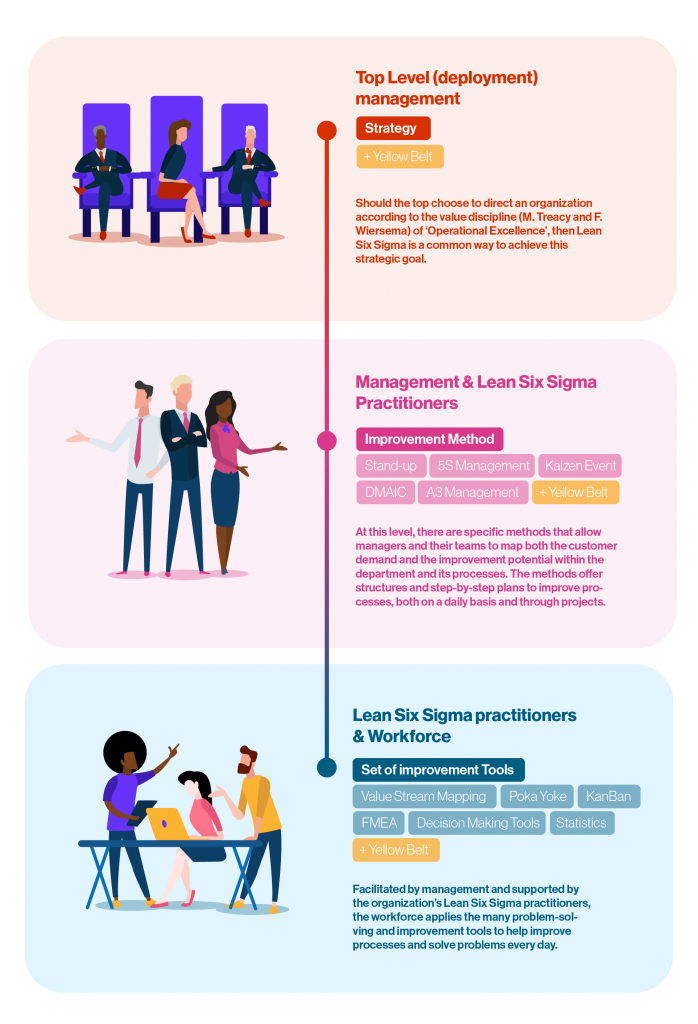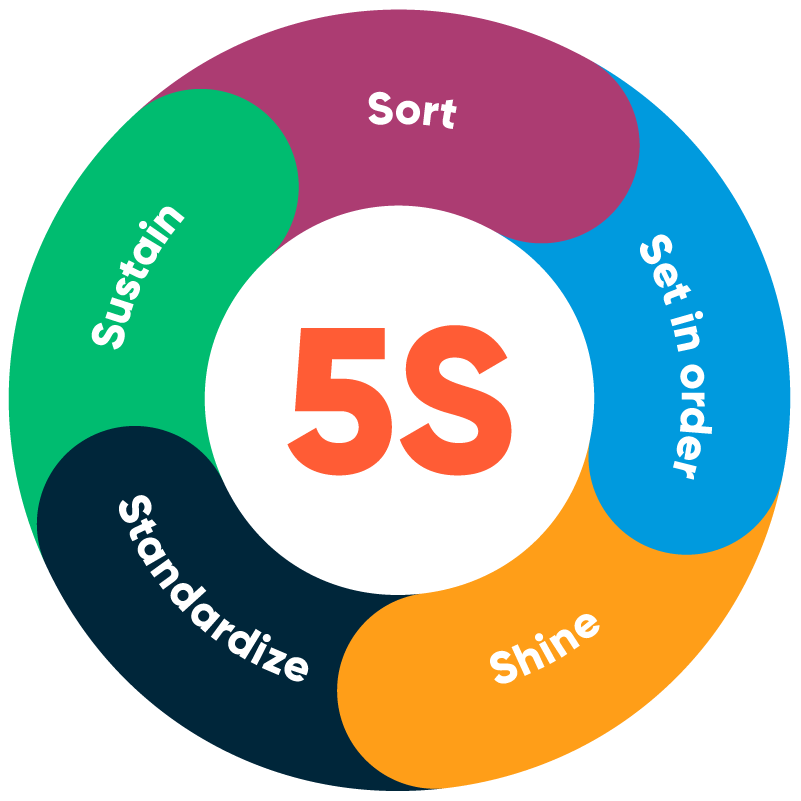What is Lean Six Sigma? A hierarchy perspective
10 August 2022
Definition: Lean Six Sigma (LSS) is a quality management method for organizations. By means of continuous improvement, Lean 6 Sigma strives to increase the speed and decrease the variation of processes. The objective is to accurately deliver what the customer wants, when they want it, at the lowest possible operational costs and with the highest possible level of flexibility.
Forthrightly stating the dictionary definition of a concept as comprehensive as Lean Six Sigma is much like spewing out facts without offering any supporting context. It is entirely true yet leaves a lot to be desired. For this reason, we have decided to explain what Lean Six Sigma is in 3 separate articles, each touching upon a different perspective. These are a historical perspective, hierarchy perspective and a practical perspective. In this article we will discuss the hierarchy perspective.
Lean Six Sigma and hierarchy
If you enter the question ‘What is Lean Six Sigma?’ into any search engine, you will find a variety of different answers. After some scrolling, you will have learned that Lean Six Sigma is either a culture, mindset, strategy, toolset, objective, improvement method, project management or a philosophy. All these answers are right, but that doesn’t really help answer the question. This is because the answer strongly depends on your hierarchical position within your organization.
For instance, to the board Lean Six Sigma is a business system and philosophy, to managers it is a comprehensive management method and to the workforce it is a set of problem-solving tools. What these interpretations have in common is that no matter what your position within the organization may be, Lean Six Sigma is always about striving to become the very best at delivering a product or a service.
That is why Lean Six Sigma organizations are easy to recognize. They deliver stable and consistent quality, are fast at what they do and put the customer’s needs above all else. Not just as a brand image manifesto, but truly anchored in the way the way they work. Because of this, Lean Six Sigma is best described as a quality management method whose success is largely dependent on organizational culture and strategic priority.
Lean Six Sigma at a strategic level
To a board of directors, deploying LSS is rarely an objective in itself. Rather, Lean Six Sigma is a business system aimed at realizing the value discipline and competitive strategy of ‘Operational Excellence’ (Treacy & Wiersma). Within this context, Lean Six Sigma is deployed throughout the entire organization to drive through a relentless focus on quality and process management. A board of directors will usually schedule monthly business reviews to monitor progress on the organization’s LSS programme and its results regarding Operational Excellence.
Lean Six Sigma at a management level
Business unit managers
The progress and results of a LSS programme are directed by management, in which we can discern between line managers (process owners) and business unit managers, where the former are in charge of a specific process and the latter, as the name implies, lead a business unit of their own. Business unit managers are responsible for connecting the organization’s Operational Excellence strategy to their business unit’s objectives.
At this level, Lean 6 Sigma is mostly a culture (and change management thereof) and an operational structure aimed at customer focus. Together with line managers, the business unit managers deploy the initiatives and select the projects that will have the most impact on their objectives. The BU-manager reports progress to the Lean Six Sigma Champion in the board and regularly discusses implementation with (external) senior Lean Six Sigma experts.
Line managers
To line managers, Lean 6 Sigma is a practical method for optimizing processes. Continuous improvement is embedded into the organization through two types of initiatives, namely daily initiatives and project-based initiatives. The line manager facilitates both initiatives. Due to this facilitating role, the line manager is required to have a theoretical understanding of the Lean Six Sigma methods but doesn’t need to be an improvement expert themselves. Their main responsibility is to encourage and help their team locate and analyze waste and improvement potential. These issues are then solved or improved by the team, under guidance from and in collaboration with Lean Six Sigma practitioners. If an issue lies beyond the line manager’s scope, they will have to bring in the business unit manager. Depending on the complexity and scope of the issue, they can decide to make it into a Black Belt project.
Lean Six Sigma at a work floor level
And last but not least, to the workforce, the team members led by their line managers, Lean Six Sigma is a way of working. Lean Six Sigma offers a comprehensive set of problem-solving tools and techniques. These are practical, easy to use techniques that help them locate, analyze and solve process issues and improvement opportunities. If the problem is known, but a solution is difficult to formulate, then the line manager can call in Lean Six Sigma practitioners, who will be able to assist and if necessary, can escalate the issue to a full blown Green Belt or Black Belt project. As the people on the work floor are closest to the process, they will know the details better than anyone else.
That is why when it comes to tracking down improvement potential, they function as the eyes and ears of both the line managers as well as the organization’s Lean Six Sigma practitioners.
More than the sum of its parts
To summarize it all, Lean Six Sigma can be interpreted differently by each layer of an organization. To the board it is a business system and a philosophy, to management it is a culture and operational structure, whereas to the workforce it is a set of problem-solving tools. The main prerequisite for all these separate interpretations of Lean Six Sigma to work is that everyone’s perspective is aligned with the organizational objectives. People from all levels of the hierarchy need to understand how their specific Lean Six Sigma actions contribute to the objectives and the organization’s strategy of Operational Excellence. That is why Lean Six Sigma is more than just the sum of its hierarchical interpretations, just as it is more than the sum of a historical, practical and hierarchical perspective.


